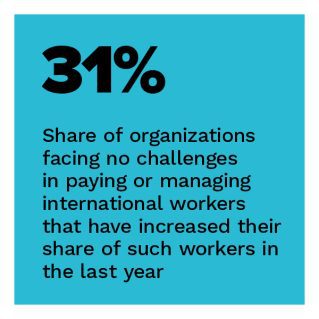80% of Firms Hit Roadblocks When Making International Workforce Payments

International hiring among U.S. and U.K. businesses skyrocketed in 2021, with organizations primarily looking to expand their business into new markets and/or increase their market share in other countries. The second most common reason for hiring internationally was to find new talent, particularly among organizations that do not have many overseas employees. 
Hiring and paying international employees involves a complex series of requirements, such as adhering to local regulations, managing taxes and dealing with fluctuating exchange rates. In fact, PYMNTS found that the challenges organizations faced in paying and managing international workers significantly impacted their interest in growing their overseas workforce — and their desire to innovate.
Among organizations that reported the need to comply with regulations in different countries as the most challenging factor when paying international workers, for instance, 60% were very or extremely interested in expanding their cross-border workforce, while 26% were very or extremely interested in innovating methods used to pay them.
“Meeting The Demand For Cross-Border Hiring: Challenges In International Workforce Payment And Management,” a PYMNTS and Nium collaboration, examines how firm revenue, size of overseas workforce and recent growth can impact international hiring.  The report also explores how challenges affect organizations’ attitudes toward increasing international hiring, innovating cross-border payment methods and enlisting a private agency. Results are based on a survey conducted between March 10 and March 29 of 250 executives in accounts payable, payroll or payments at U.S.- and U.K.-based companies with more than $100 million in annual revenue.
The report also explores how challenges affect organizations’ attitudes toward increasing international hiring, innovating cross-border payment methods and enlisting a private agency. Results are based on a survey conducted between March 10 and March 29 of 250 executives in accounts payable, payroll or payments at U.S.- and U.K.-based companies with more than $100 million in annual revenue.
More key findings from the study include:
• Four in five surveyed organizations said they have experienced challenges in paying and managing overseas workers. Only 20% of all organizations surveyed have not experienced challenges when paying or managing overseas workers, and 26% of organizations with more than a 50% share in international payroll have not experienced any such challenges. The share of organizations without challenges when paying or managing international workers drops to 14% and 13%, respectively, for companies earning $500 million to $1 billion with less than a 25% share in international payroll.
• While organizations that faced no challenges in managing and paying international workers were the most likely to significantly increase their cross-border workforce in 2021, companies that faced the most challenges were second most likely to do so.  Among organizations that did not face any challenges when paying international workers, 31% significantly increased their share of cross-border hires, as did 27% of organizations that did not face any challenges when managing overseas workers. Of the organizations that faced four to six challenges when managing international workers, 26% significantly increased their share of cross-border hires, while 23% of those facing four or five challenges did so.
Among organizations that did not face any challenges when paying international workers, 31% significantly increased their share of cross-border hires, as did 27% of organizations that did not face any challenges when managing overseas workers. Of the organizations that faced four to six challenges when managing international workers, 26% significantly increased their share of cross-border hires, while 23% of those facing four or five challenges did so.
• The more challenges organizations face, the more likely they are to use private agencies to assist with international worker recruitment and management. However, more than one-third of organizations with no challenges in managing or paying international workers have used a private agency to recruit them. Forty-three percent of companies that cited four to six challenges when managing international workers used private agencies to recruit those workers in the last 12 months, while 40% of those citing the same number of challenges did so. Of those that did not face any challenges, 35% used private agencies to recruit international workers in the last 12 months.
To learn more about how U.S. and U.K. firms are innovating to better manage and pay cross-border workforces, download the report.

